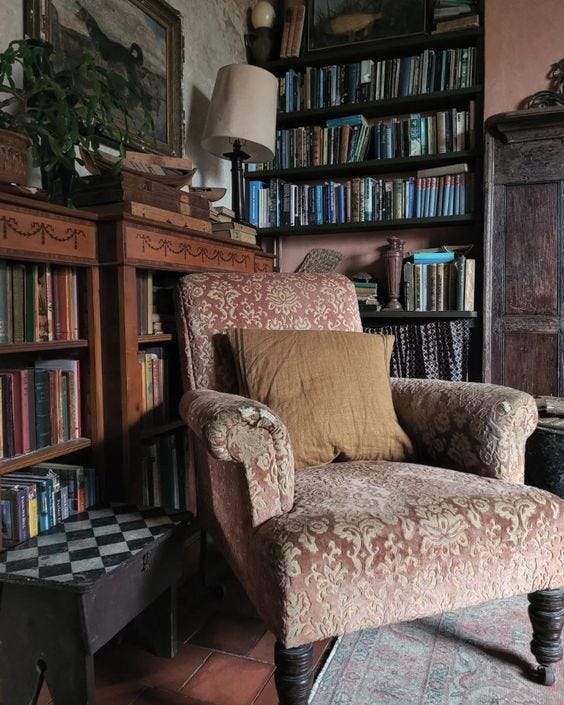Rewilding the Home
Going on a ramble through categorisation and design movements, into a summary of my design instincts.
In a world that loves to categorise I often find myself associated with the term ‘cottagecore’. I guess we fit the bill: chasing a dream of an untainted historical farmyard idyl, the handmade and the traditional, a simple pastoral lifestyle and all documented through social media. Personally I loathe the term though and would rather not be subsumed within the category.
I often mull such terms; pondering where we fit in and what terms might be used in summarising the current zeitgeist in the longer term and within wider contexts.
For some time I’ve felt that we might be living in a New Picturesque or Scenic Movement. The original Picturesque movement of the 19th Century was tied up in Romanticism; it comprised an idealization of nature, suspicion of science and industrialization, and glorification of the past. Back then these notions were captured through imagined utopian landscape paintings.
My imagined contemporary version would be similar in it’s veneration of nature and the past; but this time it is a reaction against consumerism and standardisation - not captured and spread through landscape painting but through photography and video on social media (although this same medium is also responsible for so much of the consumerism and standardisation)
Then recently I had an interview with a chap for a piece on preserving character in old houses and the discussion quickly became quite abstract and conceptual. It came to me, when trying to describe my approach to my interiors, that my approach could be described as ‘Rewilding’; undoing the strangulation of years of neatening and modernising, to allow the materials to show themselves and then let them be.
The term rewilding is usually the preserve of landscape but I see it as a thread that’s running through many parts of our lives. I don’t think it has yet become a major movement within interior design but I can see it coming:
Perhaps a near future where the fever pitch of rabid renovation has peaked and passed, the drive to turn every house into an identikit box is on the wane and a new post standardisation home rewilding movement is growing.
From an interior design standpoint I see the rewilding of the home as the unpicking of any modern layers with their low grade and harmful materials - such as standard ubiquitous manmade materials - plasterboards, chipboard kitchen units, plastic paints over once breathable surfaces etc; and from that point on choosing to do less. Not overthinking and not buying to a plan.
It is awkward as an interior designer to be promoting a design philosophy of doing less and of undoing. It is the expected role of an interior designer to add and finesse and perfect. Whereas my inclination is to stop and to listen to what the building needs, to strip back to find the origins and purposes of structures, to let the materials play out their natural processes uninhibited by the modern need to straighten, neaten and homogenise.
Inevitably as an interior designer I have had to take on jobs where the renovation brief has jarred against these instincts. However increasingly often now I’m finding clients relieved to be told that they don’t have to do things the standard way, or use materials that their tradespeople have told them is THE way to do things.
I see the process of designing an interior as a conversation with the space rather than an imperative. You wouldn’t go into a conversation with a fixed plan of how it will unfold as there is at least one other participant to inevitably lead it in alternative and chance directions. So too with design - it is important to be responsive to the direction that the spaces will lead you as the rooms unfold. Who knows what you will find as you begin to unpick a room. Taking the time to get to know the spaces before settling to any design and avoiding imposing a rigid plan of action, will ultimately lead to a space feeling fabulously settled and right.
I take the same loose approach with furnishings, I look for things that will fit but remain open to what I find. Usually the materials or pieces that make their way into a space are not what I originally imagined but are those that happened to cross our paths at an opportune moment. It’s a somewhat haphazard approach and I find myself selling things on again quite often, but as little is new it is all circular, and over time the spaces settle with their own selection as the right items find their place.
If you always stick with solid natural materials they will age well and last. Natural materials, allowed to live out their lives without undue interference, will age beautifully and tell the story of time as it passes. In a wild interior timber can warp and coffee marks can be left, raw floors scuffed and paint peeled without concern for prim puritanical values of straightness, flatness and ‘looking like new’
Currently so many spaces are put together to be superficially attractive, not made to last but destined to be wastefully renovated again before long. Rewilding our homes will ensure they feel great and waste less. These are places to really relax because that burden of needing to keep it ‘looking like new’ is lifted.











Glad that I found you.